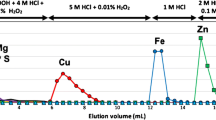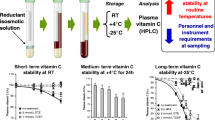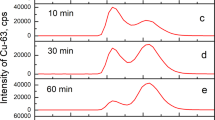Abstract
To resolve discrepancies observed in the determination of plasma exchangeable Cu (also called direct reacting Cu or loosely bound Cu) by several methods, plasma storage techniques and various aspects of a stable isotope dilution procedure for exchangeable Cu were evaluated. Results indicated that the exchangeable Cu fraction of plasma increased with storage at room temperature, at 5°C and when subjected to repeated freeze/thaw cycles. Samples could be safely stored at −65°C. Exchange between added 65Cu2+ and endogenous plasma Cu rapidly went to completion in the isotope dilution procedure. Analytical results were unaffected by shaking method, sample size or the presence of heparin. A small difference was observed between serum and plasma. The determination of exchangeable Cu did not vary over a period of 4 h when plasma was exposed to 1.6 × 10−4-M sodium diethyldithiocarbamate (used in the isotope dilution method) but steadily increased when exposed to 1.1 × 10−2-M sodium diethyldithiocarbamate, which suggested that tightly bound Cu (probably in ceruloplasmin) was exchanging with isotopic tracer at the higher concentration. Determination of exchangeable Cu was constant from pH 7.2–8.5 but increased substantially at higher pH. Complete recovery of natural Cu added to plasma was obtained. Studies in solution indicated that 65Cu2+ exchanged readily with albumin- and amino acid-bound Cu. Ultrafiltration of plasma yielded a Cu fraction about half that of the exchangeable Cu fraction. We conclude that the stable isotope dilution procedure for plasma exchangeable Cu yields reliable, physiologically meaningful results.







Similar content being viewed by others
References
Barrow L, Tanner MS (1988) Copper distribution among serum proteins in paediatric liver disorders and malignancies. Eur J Clin Invest 18:555–560
Bearn AG, Kunkel HG (1954) Localization of Cu64 in serum fractions following oral administration: an alteration in Wilson’s disease. Proc Soc Exp Biol Med 85:44–48
Buckley WT (1991) A kinetic model of copper metabolism in lactating dairy cows. Can J Anim Sci 71:155–166
Buckley WT, Vanderpool RA, Godfrey DV, Johnson PE (1996) Determination, stable isotope enrichment and kinetics of direct reacting copper in blood plasma. J Nutr Biochem 7:488–494
Cartwright GE, Wintrobe MM (1964) Copper metabolism in normal subjects. Am J Clin Nutr 14:224–232
Evans GW, Wiederanders RE (1967) Blood copper variation among species. Am J Physiol 213:1183–1185
Gordon DT, Leinart AS, Cousins RJ (1987) Portal copper transport in rats by albumin. Am J Physiol 252:E327–E333
Gubler CJ, Lahey ME, Cartwright GE, Wintrobe MM (1953) Studies on copper metabolism. IX. The transportation of copper in blood. J Clin Invest 32:405–414
Gutteridge JMC, Winyard PG, Blake DR, Lunec J, Brailsford S, Halliwell B (1985) The behavior of caeruloplasmin in stored human extracellular fluids in relation to ferroxidase II activity, lipid peroxidation and phenanthroline-detectable copper. Biochem J 230:517–523
Harris ED (1997) Copper. In: O’Dell BL, Sunde RA (eds) Handbook of nutritionally essential mineral elements. Marcel Dekker, Inc., New York
Kincaid RL, Gay CC, Krieger RI (1986) Relationship of serum and plasma copper and ceruloplasmin concentrations of cattle and the effects of whole blood sample storage. Am J Vet Res 47:1157–1159
Linder MC (1991) Biochemistry of copper, chap 4. Plenum Press, New York
Louro MO, Cocho JA, Mera A, Tutor JC (2000) Immunochemical and enzymatic study of ceruloplasmin in rheumatoid arthritis. J Trace Elem Med Biol 14:174–178
Marriott J, Perkins DJ (1966) Relationships between the copper atoms of caeruloplasmin. II. An interaction between the copper binding sites. Biochim Biophys Acta 117:395–402
Maryon EB, Molloy SA, Zimmicka AM, Kaplan JH (2007) Copper entry into human cells: progress and unanswered questions. Biometals 20:355–364
Musci G, Bonaccorsi Di Patti MC, Carlini P, Calabrese L (1992) Ceruloplasmin in human plasma and its relationship with the copper–albumin complex. Eur J Biochem 210:635–640
Noubah AM, Al-Awqati MA (1990) Ultrafilterable copper and related analytes in maternal and cord blood. Clin Chem 36:860–864
Sarkar B, Wigfield Y (1968) Evidence for albumin-Cu(II)-amino acid ternary complex. Can J Biochem 46:601–607
Sternlieb I, Morell AG, Tucker WD, Greene MW, Scheinberg TH (1961) The incorporation of copper into ceruloplasmin in vivo: studies with copper64 and copper67. J Clin Invest 40:1834–1840
Suttle NF, Field AC (1968) Effect of intake of copper, molybdenum and sulphate on copper metabolism in sheep. I. Clinical condition and distribution of copper in blood of the pregnant ewe. J Comp Path 78:351–362
Turnlund JR (1998) Human whole-body copper metabolism. Am J Clin Nutr 67:960S–964S
Van den Hamer CJA (1988) Extracellular transport of trace elements. In: Hurley LS, Keen CL, Lönnerdal B, Rucker RB (eds) Trace elements in man and animals 6. Plenum Press, New York, pp 129–133
Weiss KC, Linder MC (1985) Copper transport in rats involving a new plasma protein. Am J Physiol 249:E77–E88
Wirth PL, Linder MC (1985) Distribution of copper among components of human serum. J Natl Cancer Inst 75:277–284
Zar JH (1984) Biostatistical Analysis, 2nd edn. Prentice-Hall, Englewood Cliffs, NJ
Acknowledgements
The authors gratefully acknowledge the technical assistance of Lorna Hammerlund, Debra Hoff and David Godfrey.
Author information
Authors and Affiliations
Corresponding author
Rights and permissions
About this article
Cite this article
Buckley, W.T., Vanderpool, R.A. Analytical variables affecting exchangeable copper determination in blood plasma. Biometals 21, 601–612 (2008). https://doi.org/10.1007/s10534-008-9146-7
Received:
Accepted:
Published:
Issue Date:
DOI: https://doi.org/10.1007/s10534-008-9146-7




